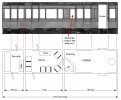RichardG
Western Thunderer
By the mid 1870s the railway coach builders were building 6-wheel family saloons to meet an increasing demand from wealthy families for exclusive accommodation. These coaches had a first class saloon with adjoining lavatory, a third class compartment for servants, and space for plenty of luggage.
I want to imagine, a Victorian entrepreneur acquired such a coach second-hand in the 1890s. The coach being useful to bring important customers to the Works, as well as for business trips. I want the coach to be a brake coach (and thus, a brake composite) so it can form an entire train on a small layout.

This is for 7mm scale. The basis is a brake third from the S&DJR, details of the source kit can be found here:
Coach Kit 6 Wheeled Brake Third
The model is not meant to be of a specific prototype but rather to look representative of a vehicle of the period. At the moment the project is mostly an exercise in understanding Victorian social values and standards, and fitting a design into the etched sides. For example, supposing the servants were there to serve and not just to go along for the ride, might there have been a connecting door from the third class compartment to the saloon? All other thoughts would be most welcome too.
I want to imagine, a Victorian entrepreneur acquired such a coach second-hand in the 1890s. The coach being useful to bring important customers to the Works, as well as for business trips. I want the coach to be a brake coach (and thus, a brake composite) so it can form an entire train on a small layout.

This is for 7mm scale. The basis is a brake third from the S&DJR, details of the source kit can be found here:
Coach Kit 6 Wheeled Brake Third
The model is not meant to be of a specific prototype but rather to look representative of a vehicle of the period. At the moment the project is mostly an exercise in understanding Victorian social values and standards, and fitting a design into the etched sides. For example, supposing the servants were there to serve and not just to go along for the ride, might there have been a connecting door from the third class compartment to the saloon? All other thoughts would be most welcome too.







